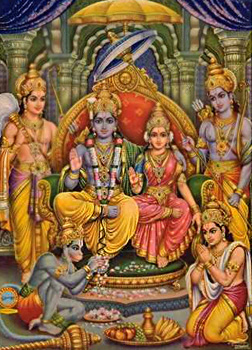 Reign of Lord Rama over the kingdom of Ayodhya was smooth and peaceful. After Rama returned from Lanka along with Lakshmana, Sita, Vibhishana, Sugriva, Hanuman, and several monkeys and bears and rakshasas, he was grandly welcomed by the people of Ayodhya. His younger brother Bharata bestowed the kingdom of Ayodhya to Rama and requested him to take control of the wealth of treasure, army, palace and all. Thus, Rama lifted his brother up and embraced him. Bharata thus restored the kingdom of Ayodhya to his brother Rama and told him that he was the only person who could bear the heavy burden of their empire. Rama accepted his request of his brother gladly.
Reign of Lord Rama over the kingdom of Ayodhya was smooth and peaceful. After Rama returned from Lanka along with Lakshmana, Sita, Vibhishana, Sugriva, Hanuman, and several monkeys and bears and rakshasas, he was grandly welcomed by the people of Ayodhya. His younger brother Bharata bestowed the kingdom of Ayodhya to Rama and requested him to take control of the wealth of treasure, army, palace and all. Thus, Rama lifted his brother up and embraced him. Bharata thus restored the kingdom of Ayodhya to his brother Rama and told him that he was the only person who could bear the heavy burden of their empire. Rama accepted his request of his brother gladly.
Coronation of Lord Rama
The preparation for the coronation of Rama to the throne of Ayodhya started. Skilful barbers came, and Rama and Lakshmana bathed and were shorn of their matted locks and dressed in shining robes; and the queens of Dasaratha attended Sita and decked her in splendid jewels, while Kaushalya decked the wives of the monkeys, and the priests gave orders for the coronation. Then Rama mounted a car driven by Bharata, and Shatrughna held the umbrella, and Lakshmana waved a chowry and Vibhishana another. Sugriva rode on an elephant, and the other monkeys followed him riding on elephants to the number of nine thousand, and with music and the noise of conchs the lord of men entered his own city. Four golden jars were given to Hanuman and Jambavan and Vegadarshi and Rishabha to fetch pure water from the four oceans, and they rose into the sky and brought the holy water from the utmost bounds of ocean, north and south and east and west. Then Vashishta, setting Rama and Sita upon their golden throne, sprinkled that first of men and consecrated him as king of Ayodhya.
When Rama became the king of Ayodhya, the gods rejoiced, and the gandharvas sang and the apsaras danced. The earth was filled with crops, the trees bore fruit and flowers, and all men were glad and merry. Rama conferred upon the Brahmins gifts of gold and ornaments, and cows and horses. He gave a golden jewelled chain such as are worn by the gods to Angada, and gave a necklace of matchless pearls and other ornaments and splendid robes to Sita. But she, getting the pearls in her hand, glanced at her lord, and then to Hanuman, remembering his goodly service. Rama thus understood her wish, granted her leave, and then she gave the necklace to Hanuman. When Hanuman wore that pearl necklace, looked like a mountain illumined by the moon and fleecy clouds. And to all other heroes Rama gave due gifts of jewels and wealth.
Vibhishana, Sugriva Leave Ayodhya
Sugriva and Hanuman and Jambavan, with the entire host, returned to their own homes, and Vibhishana prepared for his return to Lanka. Rama governed Ayodhya, and in his time men lived for a thousand years, and due rains fell, and the winds were ever favourable, and there was no suffering from sickness or from wild beasts or from invasion, but all men were glad and merry. Then, while Rama sat on the throne, all the great hermits visited him. They came from east and west and north and south, led by Agastya, and Rama worshipped them and appointed for them splendid seats of sacrificial grass and gold-embroidered deer-skin. Then the sages praised the fortune of Rama, especially for his victory over the son of Ravana, who was mightier than Ravana himself, and had delivered men and gods from fear.
Rama asked the sages about the former history of Ravana and his son Indrajit, and they related to him the story of the origin of the rakshasas as to how they came to Lanka and how Ravana, Kumbhakarna, and Vibhishana had won each a boon from the grandsire. They also told the evil deeds done by Ravana and how the gods had appointed Lord Vishnu to take human form to achieve his death. They also told of the origin and deeds of the monkeys Bali and Sugriva and Hanuman. They even told Rama that he was the incarnation of Lord Vishnu and was born in this mortal world for the slaying of the rakshasas and restoring of peace and prosperity in the world and also informed that Sita was Goddess Lakshmi. All the hosts present there were amazed after hearing the words of the sage and Agastya took leave of Rama and departed.



















